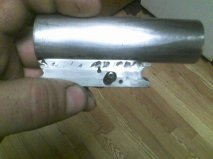- Joined
- May 20, 2013
- Messages
- 390
Barrel Profiling suggestions?
Having been bit by the Handi Rifle bug, I have bought a couple H&R single shot break barrel rifles - on is an older original H&R model 157 22 Hornet with Manlicher stock and the other three being modern NEF era guns - a 45 LC Classic Carbine, a 45-70 Buffalo Classic (32" barrel) and a 17HMR rimfire. I had the factory fit a 22 Hornet barrel to the Classic Carbine and reamed it to 22 K hornet and planned on sending it back for a .357 mag barrel, that I intended to ream to .357 Max and cut it to match the 20" 45 LC barrel, adding open sights to match the 45 LC. Problem is, H&R / Remington just shut down the accessory barrel program without any warning. So One of my projects is to attempt to duplicate the contour of the 45 LC barrel, machine a barrel lug to match and weld it to the new barrel, which will most likely be a .357 caliber. So, as a novice machinist, I have several challenges. Barrel stubbing is a popular method of making barrels for these rifles - you cut off a shotgun barrel, bore it out and thread in a blank and go. But that still leaves me wanting to match the contour of the barrel. Any thoughts on a fairly simple way to duplicate a barrel contour on a lathe? My lathe is a Harrison L6 with the taper attachment, but the taper bare is only about a foot long, and it still would not let me duplicate the rounded contours at the chamber end.
I will probably end up making more than one barrel if I am successful....
Welding questions to come later...
Dan
Having been bit by the Handi Rifle bug, I have bought a couple H&R single shot break barrel rifles - on is an older original H&R model 157 22 Hornet with Manlicher stock and the other three being modern NEF era guns - a 45 LC Classic Carbine, a 45-70 Buffalo Classic (32" barrel) and a 17HMR rimfire. I had the factory fit a 22 Hornet barrel to the Classic Carbine and reamed it to 22 K hornet and planned on sending it back for a .357 mag barrel, that I intended to ream to .357 Max and cut it to match the 20" 45 LC barrel, adding open sights to match the 45 LC. Problem is, H&R / Remington just shut down the accessory barrel program without any warning. So One of my projects is to attempt to duplicate the contour of the 45 LC barrel, machine a barrel lug to match and weld it to the new barrel, which will most likely be a .357 caliber. So, as a novice machinist, I have several challenges. Barrel stubbing is a popular method of making barrels for these rifles - you cut off a shotgun barrel, bore it out and thread in a blank and go. But that still leaves me wanting to match the contour of the barrel. Any thoughts on a fairly simple way to duplicate a barrel contour on a lathe? My lathe is a Harrison L6 with the taper attachment, but the taper bare is only about a foot long, and it still would not let me duplicate the rounded contours at the chamber end.
I will probably end up making more than one barrel if I am successful....
Welding questions to come later...
Dan
Last edited:


